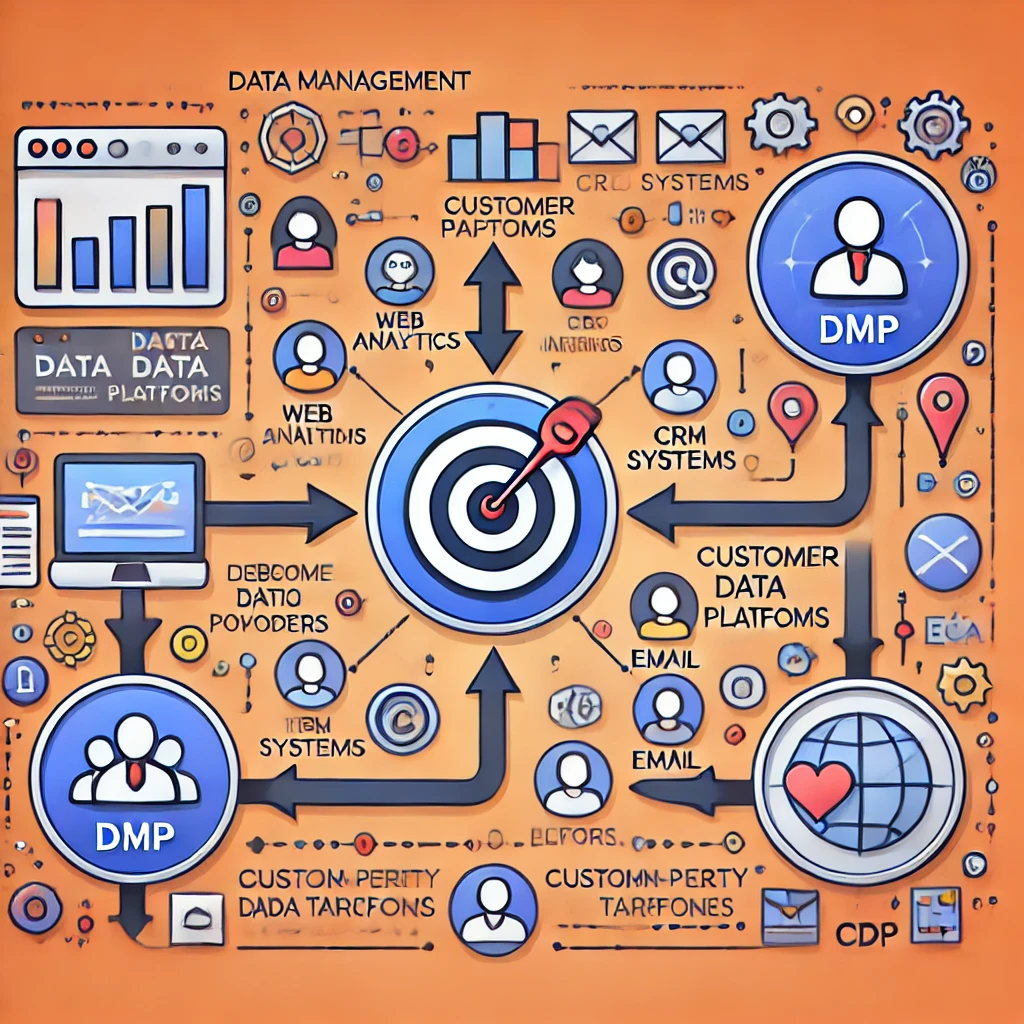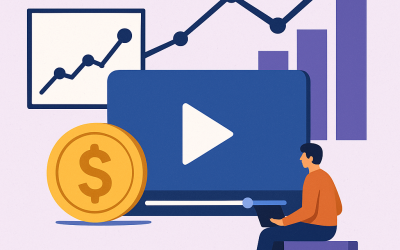Exploring the Role of DMPs and CDPs in 2024
In 2024, precise ad targeting is more crucial than ever. Consumers expect highly personalized experiences, and advertisers must leverage advanced tools to meet these expectations. Data Management Platforms (DMPs) and Customer Data Platforms (CDPs) are key players in this landscape. These platforms collect, manage, and utilize data to enhance ad targeting and optimize campaign performance.
This post explores the roles of DMPs and CDPs, their differences, and how they contribute to more effective ad targeting. Understanding these tools is essential for businesses aiming to maximize ad revenue and improve return on investment (ROI).
Contents
Understanding DMPs and CDPs
What is a DMP?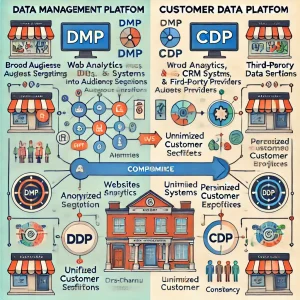
A Data Management Platform (DMP) collects, organizes, and analyzes large volumes of data from various sources. This data typically includes anonymized third-party data used to create audience segments. Advertisers use these segments to target specific groups across different channels, such as display, video, and social media.
Key Functions of a DMP:
- Data Aggregation: DMPs gather data from web analytics, CRM systems, and third-party providers. They categorize this data into audience segments based on demographics, behavior, and interests.
- Audience Segmentation: DMPs organize data into segments that can be targeted with specific ads. For example, a segment could consist of users interested in luxury cars.
- Ad Campaign Facilitation: DMPs integrate with Demand-Side Platforms (DSPs) to facilitate ad buying. This integration allows advertisers to target audience segments across multiple channels efficiently.
Benefits for Advertisers:
- Broader Reach: DMPs enable advertisers to target large audience segments across various channels. This approach enhances the scale of ad campaigns.
- Improved Ad Relevance: Precise audience segmentation ensures that ads are relevant to the target audience. Relevant ads increase engagement and conversion rates.
- Optimized Ad Spend: DMPs help advertisers target only the most relevant segments, reducing wasted impressions and optimizing ad spend.
What is a CDP?
A Customer Data Platform (CDP) collects and manages first-party data to create unified customer profiles. Unlike DMPs, which focus on third-party data, CDPs concentrate on data gathered directly from customers through various touchpoints, such as website interactions, email engagement, and purchase history.
Key Functions of a CDP:
- Data Integration: CDPs unify customer data from websites, apps, CRM systems, and email platforms into a single customer profile.
- Customer Segmentation: CDPs enable detailed segmentation based on first-party data. For example, a CDP can segment customers who purchased a specific product within the last month.
- Personalization: CDPs use unified customer profiles to personalize marketing messages and experiences across all channels, ensuring each customer receives relevant content.
Benefits for Advertisers:
- Personalized Marketing: CDPs allow highly personalized marketing campaigns by providing insights into customer preferences and behaviors.
- Enhanced Customer Engagement: By delivering relevant content, CDPs help increase customer engagement and loyalty, leading to higher conversion rates.
- Cross-Channel Consistency: CDPs ensure customers receive a consistent experience across all channels. This consistency strengthens brand perception and increases customer retention.
Comparing DMPs and CDPs
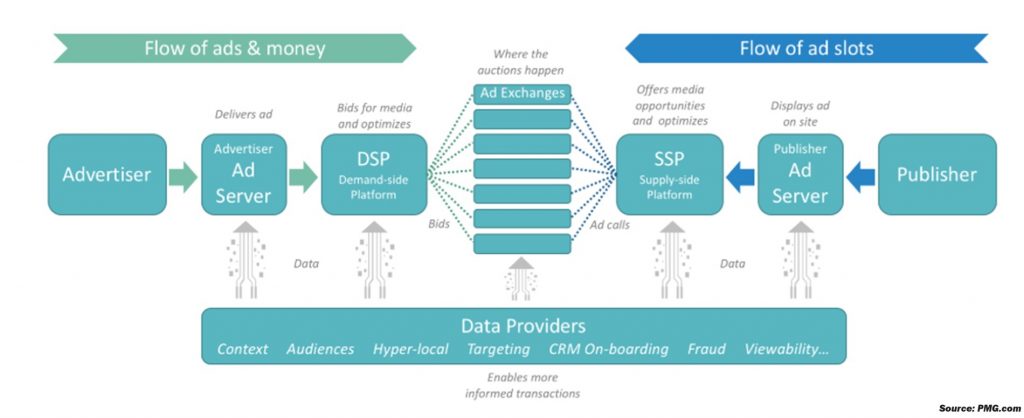
Continuing on Part 7 – Exploring the Role of DMPs and CDPs in 2024 and Beyond post,
Data Sources
- DMPs: Rely on third-party data, aggregated and anonymized, to create broad audience segments. This data helps reach new audiences.
- CDPs: Focus on first-party data, providing a detailed and personalized understanding of individual customers. This data is essential for creating comprehensive customer profiles.
Use Cases
- DMPs: Are most effective for broad audience targeting in programmatic advertising. They excel at reaching new customers matching the desired audience segments.
- CDPs: Excel in personalized marketing and customer retention. They are particularly useful in nurturing existing customer relationships and enhancing customer lifetime value.
Integration with Other Tools
- DMPs: Integrate with DSPs and other ad tech tools to facilitate targeted ad buys. This integration allows for seamless execution of programmatic campaigns.
- CDPs: Integrate with marketing automation platforms, CRM systems, and other tools to support personalized marketing strategies. This ensures that customer interactions are informed by the same data, creating a cohesive experience.
The Impact of DMPs and CDPs on Ad Targeting
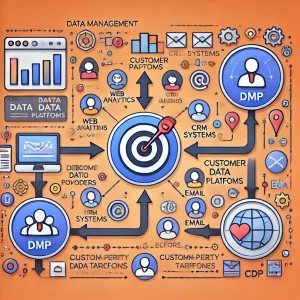 Enhanced Targeting Precision
Enhanced Targeting Precision
- DMPs’ Contribution: DMPs improve targeting precision by enabling advertisers to segment audiences at scale. This segmentation allows more targeted ad placements, increasing the likelihood of reaching the right audience with the right message.
- CDPs’ Contribution: CDPs provide deeper insights into individual customer behaviors and preferences. This level of personalization enhances customer engagement and campaign effectiveness.
Improved ROI
- Measuring Effectiveness: Integrating DMPs and CDPs into advertising strategies leads to better-targeted campaigns, reduced ad spend waste, and higher ROI. These platforms help maximize the impact of each ad dollar spent.
- Case Studies/Examples: A retail brand that used a CDP to unify customer data saw a 20% increase in conversion rates due to personalized marketing efforts. A DMP-enabled campaign by an automotive company reduced cost-per-acquisition (CPA) by 15% through precise audience targeting.
Challenges and Considerations
Continuing on Part 7 – Exploring the Role of DMPs and CDPs in 2024 and Beyond post, here are some challenges –
Data Privacy and Compliance
- GDPR and CCPA: Both DMPs and CDPs must comply with data privacy regulations like GDPR and CCPA. These laws require businesses to handle personal data responsibly and obtain explicit user consent.
- User Consent: Managing user consent is a significant challenge, especially for DMPs relying on third-party data. Businesses must have proper mechanisms in place to obtain and manage user consent in compliance with these regulations.
Choosing the Right Platform
- Business Needs: When deciding between a DMP and a CDP, businesses should consider their specific needs. For example, a DMP might be the better choice if the goal is to acquire new customers at scale. However, if the focus is on personalizing the customer experience and improving retention, a CDP would be more appropriate.
- Integration Complexity: Businesses should also consider the complexity of integrating these platforms with their existing ad tech stack. DMPs may require integration with multiple third-party data sources, while CDPs may need to connect with various internal systems like CRM and marketing automation platforms.
AppLixir Rewarded Video Ad
In summary, of my Part 7 – Exploring the Role of DMPs and CDPs in 2024 and Beyond post, DMPs and CDPs are powerful tools that enhance ad targeting by leveraging data in different ways. DMPs excel at broad audience targeting using third-party data, while CDPs focus on personalizing marketing efforts using first-party data. Both platforms play a crucial role in improving ad campaign performance and maximizing ROI.
As digital advertising evolves, the need for precise targeting will only grow. Now is the time to assess your data strategy and consider how these platforms can help you achieve your marketing goals. AppLixir, a Rewarded Video Ad Platform, helps games and content sites monetize their inventory effectively. For more info, reach out to us at info@blog.applixir.com!
